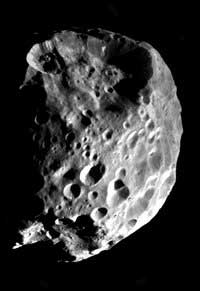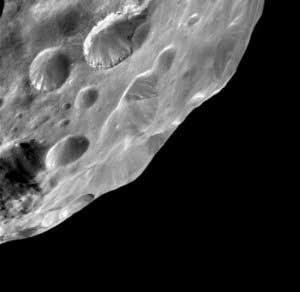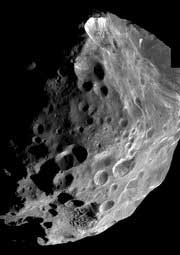Phoebe (fee'-bee, Greek Φοίβη) is a moon of Saturn. It was discovered by William Henry Pickering on March 17, 1899 from photographic plates that had been taken starting on August 16, 1898 at Arequipa, Peru by DeLisle Stewart. It was the first satellite to be discovered photographically.
 |
|
| Discovery | |
|---|---|
| Discovered by | W.H. Pickering |
| Discovered in | March 17, 1899 / August 16, 1898 |
| Orbital characteristics [1] | |
| Semimajor axis | 12,955,759 km |
| Eccentricity | 0.1562415 |
| Orbital period | 550.564636 d |
| Inclination | 151.66° (to Saturn's equator) [2] |
| Is a satellite of | Saturn |
| Physical characteristics | |
| Diameter | 230 x 220 x 210 km |
| Mass | 7.2x1018 kg |
| Mean density | 2.3 g/cm3 |
| Surface gravity | 0.039 m/s2 |
| Rotation period | 0.38675 d (9 h 16 min 55.2 s) [3] |
| Axial tilt | 17.4° [4] |
| Albedo | 0.06 |
| Atmosphere | none |
Name
The moon is named after Phoebe, a Titan in Greek mythology. It is also designated Saturn IX. The IAU nomenclature standards have stated that features on Phoebe are to be named after characters in the Greek myth of Jason and the Argonauts. In 2005, the IAU officially named 24 craters (Acastus, Admetus, Amphion, Butes, Calais, Canthus, Clytius, Erginus, Euphemus, Eurydamas, Eurytion, Eurytus, Hylas, Idmon, Iphitus, Jason, Mopsus, Nauplius, Oileus, Peleus, Phlias, Talaus, Telamon, and Zetes).
Dr. Toby Owen of the University of Hawaii at Manoa, chairman of the International Astronomical Union Outer Solar System Task Group said
"We picked the legend of the Argonauts for Phoebe as it has some resonance with the exploration of the Saturn system by Cassini-Huygens. We can't say that our participating scientists include heroes like Hercules and Atalanta, but they do represent a wide, international spectrum of outstanding people who were willing to take the risk of joining this voyage to a distant realm in hopes of bringing back a grand prize."
Orbital characteristics
For more than 100 years, Phoebe was Saturn's outermost known moon, until the discovery of several smaller moons in 2000. Phoebe is almost 4 times more distant from Saturn than its nearest major neighbor (Iapetus), and is substantially larger than any of the other moons orbiting planets at comparable distances.
All of Saturn's moons up to Iapetus orbit very nearly in the plane of Saturn's equator. The outer moons can be broken down into two groups: Siarnaq's group (Kiviuq, Ijiraq, Paaliaq, Albiorix, Erriapo, Siarnaq and Tarvos) is inclined 33.5-46.5° whilst Phoebe's group (Phoebe, Skathi, Narvi, Mundilfari, Suttungr, Thrymr and Ymir) is retrograde and inclined 134.5-175.5°. Both groups are fairly to highly eccentric, and none of their moons are expected to rotate synchronously as all the inner moons of Saturn do (except for Hyperion). The inclinations given are with respect to the solar system's ecliptic rather than Saturn's equator, as the local Laplace plane at these distances is already quite tilted with respect to Saturn's equator. This tilt reaches 15° at Iapetus' distance; at Phoebe's, it has already merged with the ecliptic (tilt of 26°).
Physical characteristics

Closeup image of Phoebe from the Cassini-Huygens spacecraft, June 13, 2004.
Phoebe is roughly spherical and has a diameter of 220 kilometres (about 137 miles), which is equal to about one-fifteenth of the diameter of Earth's moon. Phoebe rotates on its axis every nine hours and it completes a full orbit around Saturn in about 18 months. Its surface temperature is only 75 K (-198°C).
Most of Saturn's inner moons have very bright surfaces, but Phoebe's albedo is very low (0.06), as dark as lamp black. The Phoebean surface is extremely heavily scarred, with craters up to 80 kilometres across, one of which has walls 16 kilometres high.
Phoebe's dark colouring initially led to scientists surmising that it was a captured asteroid, as it resembled the common class of dark carbonaceous asteroids. These are chemically very primitive and are thought to be composed of original solids that condensed out of the solar nebula with little modification since then.
However, images from the Cassini-Huygens space probe indicate that Phoebe's craters show a considerable variation in brightness, which indicate the presence of large quantities of ice below a relatively thin blanket of dark surface deposits some 300 to 500 metres (980 to 1,600 feet) thick. In addition, quantities of carbon dioxide have been detected on the surface, a finding which has never been replicated on an asteroid. It is estimated that Phoebe is about 50% rock, as opposed to the 35% or so that typifies Saturn's inner moons. For these reasons, scientists are coming to believe that Phoebe is in fact a captured Centaur, one of a number of icy planetoids from the Kuiper belt that orbit the Sun between Jupiter and Neptune. [5] Phoebe is the first such object to be imaged as anything other than a dot.
Material displaced from Phoebe's surface by microscopic meteor impacts may be responsible for the dark surfaces of Hyperion and the leading hemisphere of Iapetus. Debris from the biggest impacts may have been the building blocks of the other moons of Phoebe's group—all of which are less than 10 km in diameter.
Spacecraft flybys

Closeup image of Phoebe from Cassini-Huygens
The Voyager 2 spacecraft passed by Phoebe in September 1981, although the 2.2 Gm (2.2 million kilometres) distance and low resolution meant that relatively little could be learned from the resulting images.
The Cassini spacecraft flew within 2,068 kilometers (about 1,285 miles) of Phoebe on June 11, 2004, returning many high-resolution images of the moon and its scarred surface.
See also
List of geological features on Saturn's smaller moons
... | Ijiraq | Phoebe | Paaliaq | ...
Saturn's natural satellites
Pan | Daphnis | Atlas | Prometheus | S/2004 S 6 | S/2004 S 4 | S/2004 S 3 | Pandora | Epimetheus and Janus | Mimas | Methone | Pallene | Enceladus | Telesto, Tethys, and Calypso | Polydeuces, Dione, and Helene | Rhea | Titan | Hyperion | Iapetus | Kiviuq | Ijiraq | Phoebe | Paaliaq | Skathi | Albiorix | S/2004 S 11 | Erriapo | Siarnaq | S/2004 S 13 | Tarvos | Mundilfari | S/2004 S 17 | Narvi | S/2004 S 15 | S/2004 S 10 | Suttungr | S/2004 S 12 | S/2004 S 18 | S/2004 S 9 | S/2004 S 14 | S/2004 S 7 | Thrymr | S/2004 S 16 | Ymir | S/2004 S 8
see also: Rings of Saturn | Cassini-Huygens | Themis
Retrieved from "http://en.wikipedia.org/"
All text is available under the terms of the GNU Free Documentation License

